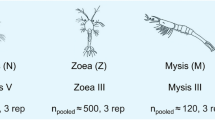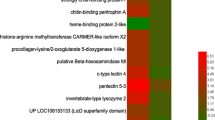Abstract
Shrimps are believed to lack an adaptive immune system and therefore rely heavily on their innate immune mechanisms to ward off pathogens. Moreover, their innate defense reactions are triggered by bacterial and fungal cell wall components such as lipopolysaccharides, peptidoglycan and β-glucans. In this study, we used microarray to examine the gene expression profile of kuruma shrimp, Marsupenaeus japonicus, after stimulation with peptidoglycan. Subsequent results show that the number of upregulated genes and percentage of differential expression (21%) was highest at day 1 poststimulation. Differentially expressed genes in day 7 and day 14, on the other hand, were 3.25% and 11.21%, respectively. Sixty-one (61) genes of unknown function were found to have responded outright to peptidoglycan (PG) stimulation. Administration of PG also caused increases in the expressions of crustin, lysozyme, and a few antibacterial peptides, all of which are known to be involved in crustacean immune response. Taken together, our results suggest that innate response in shrimp is triggered instantaneously upon exposure to a bacterial component.





Similar content being viewed by others
References
Amparyup P, Kondo H, Hirono I, Aoki T, Tassanakajon A (2008) Molecular cloning, genomic organization and recombinant expression of a crustin-like antimicrobial peptide from black tiger shrimp Penaeus monodon. Mol Immunol 45:1085–1093
Auslander M, Yudkovski Y, Chalifa-Caspi V, Herut B, Ophir R, Reinhardt R, Neumann PM, Tom M (2008) Pollution-affected fish hepatic transcriptome and its expression patterns on exposure to cadmium. Mar Biotechnol 10(3):250–261
Azad I, Panigrahi A, Gopal C, Paulpandi S, Mahima C, Ravichandran P (2005) Routes of Immunostimulation vis-à-vis survival and growth of Penaeus monodon postlarvae. Aquaculture 248:227–234
Bachere E, Gueguen Y, Gonzalez M, De Lorgeril J, Garnier J, Romestand B (2004) Insights into the anti-microbial defense of marine invertebrates: the penaeid shrimps and the oyster Crassostrea gigas. Immunol Rev 198:149–168
Chang CF, Chen HY, Su MS, Liao IC (2000) Immunomodulation by dietary beta-1, 3-glucan in the brooders of the black tiger shrimp Penaeus monodon. Fish Shellfish Immunol 10:505–514
Chang CF, Su MS, Chen HY, Liao IC (2003) Dietary beta-1,3-glucan effectively improves immunity and survival of Penaeus monodon challenged with white spot syndrome virus. Fish Shellfish Immunol 15:297–310
Citarasu T, Sivaram V, Immanuel G, Rout N, Murugan V (2006) Influence of selected Indian immunostimulant herbs against white spot syndrome virus (WSSV) infection in black tiger shrimp, Penaeus monodon with reference to haematological, biochemical and immunological changes. Fish Shellfish Immunol 21:372–384
Darias MJ, Zambonino-Infante JL, Hugot K, Cahu CL, Mazurais D (2008) Gene expression patterns during the larval development of European sea bass (Dicentrarchus labrax) by microarray analysis. Mar Biotechnol (NY) 10:416-428
Decook R, Nettleton D, Foster C, Es W (2006) Identifying differentially expressed genes in unreplicated multi-treatment microarray timecourse experiments. Comput Stat Data Anal 50:518–532
De Hoon M, Imoto S, Nolan J, Miyano S (2004) Open source clustering software. Bioinformatics 20:1453–1454
Dhar A, Dettori A, Roux M, Klimpel K, Read B (2003) Identification of differentially expressed genes in shrimp (Penaeus stylirostis) infected with White Spot Syndrome Virus by cDNA microarrays. Arch Virol 148:2381–2396
Duojiao N, Song L, Wu L, Chang Y, Yu Y, Qui L, Wang L (2007) Molecular cloning and mRNA expression of peptidoglycan recognition protein (PGRP) gene in bay scallop (Argopecten irradians, Lamarck 1819). Dev Comp Immunol 31:548–558
Guan R, Mariuzza RA (2007) Peptidoglycan recognition proteins of the innate immune system. Trends Microbiol 15:127–134
Hou WY, Chen JC (2005) The immunostimulatory effect of hot-water extract of Gracilaria tenuistipitata on the white shrimp Litopenaeus vannamei and its resistance against Vibrio alginolyticus. Fish Shellfish Immunol 19:127–138
Itami T, Kondo M, Uozu M, Suganuma A, Abe T, Nakagawa A, Suzuki N, Takahashi Y (1996) Enhancement of disease resistance against Enterococcus seriolicida infection in yellowtail Seriola quinqueradiata Temminck and Schlegel by oral administration of peptidoglycan derived from Bifidobacterium thermophilum. J Fish Dis 19:185–187
Itami T, Asano M, Tokushige K, Kubono K, Nakagawa A, Takeno N, Nishimura H, Maeda M, Kondo M, Takahashi Y (1998) Enhancement of disease resistance of kuruma shrimp, Panaeus japonicus, after oral administration of peptidoglycan derived from Bifobacterium thermophilium. Aquaculture 164:277–288
Jenny MJ, Chapman RW, Mancia A, Chen YA, Mckillen DJ, Trent H, Lang P, Escoubas JM, Bachere E, Boulo V, Liu ZJ, Gross PS, Cunningham C, Cupit PM, Tanguy A, Guo X, Moraga D, Boutet I, Huvet A, De Guise S, Almeida JS, Warr GW (2007) A cDNA microarray for Crassostrea virginica and C. gigas. Mar Biotechnol 9:577–591
Khadijah S, Neo S, Hossain M, Miller L, Mathavan S, Kwang J (2003) Identification of White Spot Syndrome Virus latency-related genes in specific-pathogen-free shrimps by use of a microarray. J Virol 77:10162–10167
Klannukarn SS, Wongprasert K (2004) Vibrio bacterin and carboxymenthyl b-1,-3-glucans protect Penaeus monodon from Vibrio harveyi infection. J Aquat Anim Health 16:238–245
Kochzius M, Nolte M, Weber H, Silkenbeumer N, Hjorleifsdottir S, Hreggvidsson GO, Marteinsson V, Kappel K, Planes S, Tinti F, Magoulas A, Garcia Vazquez E, Turan C, Hervet C, Campo Falgueras D, Antoniou A, Landi M, Blohm D (2008) DNA microarrays for identifying fishes. Mar Biotechnol (NY) 10:207–217
Kong HJ, Cho HK, Park E-M, Hong G-E, Kim Y-O, Nam B-H, Kim W-J, Lee S-J, Han HS, Jang I-K, Lee CH, Cheong JH, Choi T-J (2008). Molecular cloning of Kazal-type proteinase inhibitor of the shrimp Fenneropenaeus chinensis. Fish Shellfish Immunol DOI 10.1016/j.fsi.2008.03.023
Kurobe T, Yasuike M, Kimura T, Hirono I, Aoki T (2005) Expression profiling of immune-related genes from Japanese flounder Paralichthys olivaceus kidney cells using cDNA microarrays. Dev Comp Immunol 29:515–523
Lan Y, Xu X, Yang F, Zhang X (2006) Transcriptional profile of shrimp white spot syndrome virus (WSSV) genes with DNA microarray. Arch Virol 151:1723–1733
Lee S, Söderhäll K (2002) Early events in crustacean innate immunity. Fish Shellfish Immunol 12:421–437
Lewin B (2004) Genes VIII. Pearson Education, Inc, Pearson Prentice Hall
Liu WJ, Chang YS, Wang CH, Kou GH, Lo CF (2005) Microarray and RT-PCR screening for white spot syndrome virus immediate-early genes in cycloheximide-treated shrimp. Virology 334:327–341
Maningas MB, Kondo H, Hirono I, Saito-Taki T, Aoki T (2008) Essential function of transglutaminase and clotting protein in shrimp immunity. Mol Immunol 45:1269–1275
Marks H, Vorst O, Van Houwelingen AM, Van Hulten MC, Vlak JM (2005) Gene-expression profiling of White spot syndrome virus in vivo. J Gen Virol 86:2081–2100
Matsuo K, Miyazano I (1993) The influence of long-term administration of peptidoglucan on disease resistance and growth of juvenile rainbow trout. Nippon Suisan Gakkaishi 59:1377–1379
McDonald C, Inohara N, Nunez G (2005) Peptidoglycan signaling in innate immunity and inflammatory disease. J Biol Chem 280:20177–20180
Misra CK, Das BK, Pradhan J, Pattnaik P, Sethi S, Mukherjee SC (2004) Changes in lysosomal enzyme activity and protection against Vibrio infection in Macrobrachium rosenbergii (De Man) post larvae after bath immunostimulation with beta-glucan. Fish Shellfish Immunol 17:389–395
Moriya S, Sato S, Azumaya T, Suzuki O, Urawa S, Urano A, Abe S (2007) Genetic stock identification of chum salmon in the Bering Sea and North Pacific Ocean using mitochondrial DNA microarray. Mar Biotechnol (NY) 9:179–191
Okumura T (2007) Effects of lipopolysaccharides on gene expression of antibacterial peptides (penaeidins and crustin), serine proteinase and prophenoloxidase in haemocytes of the Pacific white shrimp, Litopenaeus vannamei. Fish Shellfish Immunol 22:68–76
Peng X, Wood CL, Blalock EM, Chen KC, Landfield PW, Stromberg AJ (2003) Statistical implications of pooling RNA samples for microarray experiments. BMC Bioinformatics 4:26–35
Rattanachai A, Hirono I, Ohira T, Takahashi Y, Aoki T (2004) Cloning of kuruma prawn Marsupenaeus japonicus crustin-like peptide cDNA and analysis of its expression. Fish Sci 70:765–771
Rattanachai A, Hirono I, Ohira T, Takahashi Y, Aoki T (2005) Peptidoglycan inducible expression of a serine proteinase homologue from kuruma shrimp (Marsupenaeus japonicus). Fish Shellfish Immunol 18:39–48
Rojtinnakorn J, Hirono I, Itami T, Takahashi Y, Aoki T (2002) Gene expression in haemocytes of kuruma prawn, Penaeus japonicus, in response to infection with WSSV by EST approach. Fish Shellfish Immunol 13:69–83
Sakai M (1999) Current research status of fish immunostimulants. Aquaculture 172:63–92
Saldanha AJ (2004) Java Treeview—extensible visualization of microarray data. Bioinformatics 20:3246–3248
Smith VJ, Brown JH, Hauton C (2003) Immunostimulation in crustaceans: does it really protect against infection? Fish Shellfish Immunol 15:71–90
Song YL, Liu JJ, Chan LC, Sung HH (1997) Glucan-induced disease resistance in tiger shrimp (Penaeus monodon). Dev Biol Stand 90:413–421
Sritunyalucksana K, Sithisarn P, Withayachumnarnkul B, Flegel T (1999) Activation of prophenoloxidase, agglutinin and antibacterial activity in haemolymph of the black tiger prawn, Penaeus monodon, by immunostimulants. Fish Shellfish Immunol 9:21–30
Stears RL, Martinsky T, Schena M (2003) Trends in microarray analysis. Nat Med 9:140–145
Steiner H (2004) Peptidoglycan recognition proteins: on and off switches for innate immunity. Immunol Rev 198:83–96
Supungul P, Klinbunga S, Pichyangkura R, Jitrapakdee S, Hirono I, Aoki T, Tassanakajon A (2002) Identification of immune-related genes in hemocytes of black tiger shrimp (Penaeus monodon). Mar Biotechnol (NY) 4:487–494
Supungul P, Tang S, Maneeruttanarungroj C, Rimphanitchayakit V, Hirono I, Aoki T, Tassanakajon A (2008) Cloning, expression and antimicrobial activity of crustinPm1, a major isoform of crustin, from the black tiger shrimp Penaeus monodon. Dev Comp Immunol 32:61–70
Takahashi Y, Kondo M, Itami T, Honda T, Inagawa H, Nishizawa T, Soma G-I, Yokomizo Y (2000) Enhancement of disease resistance against penaeid acute viraemia and induction of virus-activating activity in haemolymph of kuruma shrimp, Penaeus japonicus, by oral administration of Pantoea agglomerans lipopolysaccharide (LPS). Fish Shellfish Immunol 10:555–558
Tincu JA, Taylor SW (2004) Antimicrobial peptides from marine invertebrates. Antimicrob Agents Chemother 48:3645–3654
Tsai JM, Wang HC, Leu JH, Hsiao HH, Wang AH, Kou GH, Lo CF (2004) Genomic and proteomic analysis of thirty-nine structural proteins of shrimp white spot syndrome virus. J Virol 78:11360–11370
Tyagi A, Khushiramani R, Karunasagar I, Karunasagar I (2007) Antivibrio activity of recombinant lysozyme expressed from black tiger shrimp, Penaeus monodon. Aquaculture 272:246–253
Wang B, Li F, Dong B, Zhang X, Zhang C, Xiang J (2006) Discovery of the genes in response to white spot syndrome virus (WSSV) infection in Fenneropenaeus chinensis through cDNA microarray. Mar Biotechnol (NY) 8:491–500
Wongpanya R, Yasuike M, Aoki T, Hirono I, Tassanakjon A (2007) Analysis of gene expression in haemocyte of shrimp Penaeus monodon challenged with white spot syndrome virus by cDNA microarray. Sci Asia 33:165–174
Yasuike Y, Kondo H, Hirono I, Aoki T (2006) Difference in Japanese flounder, Paralichthys olivaceus gene expression profile following hirame rhabdovirus (HIRRV) G and N protein DNA vaccination. Fish Shellfish Immunol 23:531–541
Yeh ST, Lee CS, Chen JC (2006) Administration of hot-water extract of brown seaweed Sargassum duplicatum via immersion and injection enhances the immune resistance of white shrimp Litopenaeus vannamei. Fish Shellfish Immunol 20:332–345
Acknowledgments
This study was supported in part by Grants-in-Aid for Scientific Researches from the Ministry of Education, Culture, Sports, Science and Technology of Japan and the grant from the Japan Science and Technology Corporation (JST); Creation and Support Program for Start-ups from Universities. Special thanks to Mr. Mudjekeewis D. Santos for proofreading the manuscript.
Author information
Authors and Affiliations
Corresponding author
Electronic supplementary material
Below is the link to the electronic supplementary material.
Supplementary Table 1
Differentially expressed genes in each sampling period (DOC 292 KB)
Supplementary Table 2
Overview of clustered genes with their corresponding deduced functions (DOC 215 KB)
Rights and permissions
About this article
Cite this article
Fagutao, F.F., Yasuike, M., Caipang, C.M. et al. Gene Expression Profile of Hemocytes of Kuruma Shrimp, Marsupenaeus japonicus Following Peptidoglycan Stimulation. Mar Biotechnol 10, 731–740 (2008). https://doi.org/10.1007/s10126-008-9110-0
Received:
Revised:
Accepted:
Published:
Issue Date:
DOI: https://doi.org/10.1007/s10126-008-9110-0




